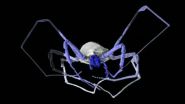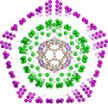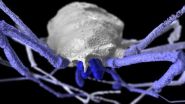(Press-News.org) The activity of four transcription factors – proteins that regulate the expression of other genes – appears to distinguish the small proportion of glioblastoma cells responsible for the aggressiveness and treatment resistance of the deadly brain tumor. The findings by a team of Massachusetts General Hospital (MGH) investigators, which will be published in the April 24 issue of Cell and are receiving advance online release, support the importance of epigenetics – processes controlling whether or not genes are expressed – in cancer pathology and identify molecular circuits that may be targeted by new therapeutic approaches.
"We have identified a code of 'molecular switches' that control a very aggressive subpopulation of brain cancer cells, so-called glioblastoma stem cells," says Mario Suvà, MD, PhD, of the MGH Department of Pathology and Center for Cancer Research, co-lead author of the Cell article. "Understanding what drives these aggressive cells will give us insights into alternative ways of eliminating them and potentially changing the course of this very deadly tumor."
Normal biological development follows an orderly hierarchical progression from stem cells, capable of differentiating into almost any type of cell, to progenitor cells, giving rise to specific subtypes of cells and tissues, to fully differentiated cells. While the process usually proceeds in a one-way direction, artificially inducing the activity of key transcription factors can reprogram differentiated cells back into a stem-like state, a discovery honored with the 2012 Nobel prize.
Small populations of adult stem cells with somewhat limited developmental potential are responsible for the body's ability to heal injuries and replace worn out cells and tissues, and evidence is growing that rare cancer stem cells are responsible for the uncontrolled growth of some malignant tumors, including glioblastoma. Several studies have used cell-surface markers – proteins found on the outer membranes of tumor cells – to identify glioblastoma stem cells; but the specific markers used have been controversial and cannot reflect molecular processes going on within tumor cells. The current study was designed to clarify the cellular hierarchy underlying glioblastoma, to identify epigenetic factors that distinguish glioblastoma stem cells from more differentiated tumor cells and to suggest potential therapies targeting those factors.
In a series of experiments, the researchers first identified a set of 19 transcription factors that were expressed at significantly greater levels in cultured human glioblastoma stem cells capable of tumor propagation than in differentiated tumor cells. Testing each of these factors for their ability to return differentiated tumor cells to a stem-like state, identified a combination of four – POU3F2, SOX2, SALL2 and OLIG2 – that was able to reprogram differentiated tumor cells back into glioblastoma stem cells, both in vitro and in an animal model.
The investigators then confirmed that these four factors and their corresponding regulatory elements – the DNA segments to which transcription factors bind – were active in from 2 to 7 percent of human glioblastoma cells, cells that also expressed a known stem cell marker. They also showed that inhibiting the action of an important regulatory protein complex that involves a known target gene of one of the core transcription factors – a gene active in stem-like glioblastoma cells but not differentiated cells – caused glioblastoma stem cells to lose their stem-like properties and die.
"This study brings us back to the fundamental idea that there are many reasons that cancer cells can be aggressive," explains senior author Bradley Bernstein, MD, PhD, of MGH Pathology and the MGH Cancer Center. "Just as normal cells with the same genome differentiate into many different cell types, a single tumor characterized by specific genetic mutations can contain many different types of cells – stem-like and more differentiated cells – with the difference being rooted in their epigenetic information. Identifying the drivers of these different cellular states in glioblastoma stem cells could offer us the best opportunity for treating what remains an extremely difficult-to -treat tumor."
INFORMATION:
Bernstein is a professor of Pathology at Harvard Medical School, and Suvà recently joined the faculty at MGH Department of Pathology and MGH Cancer Center. Esther Rheinbay, PhD, MGH Pathology and Center for Cancer Research, is co-lead author of the Cell paper. Additional co-authors include David Louis, MD, MGH Pathology, and collaborators from the Klarman Cell Observatory at the Broad Institute. The work was supported by grants from the Howard Hughes Medical Institute, the Starr Cancer Consortium, the Burroughs Wellcome Fund, the Harvard Stem Cell Institute, Oncosuisse and the Klarman Family Foundation.
Massachusetts General Hospital, founded in 1811, is the original and largest teaching hospital of Harvard Medical School. The MGH conducts the largest hospital-based research program in the United States, with an annual research budget of more than $775 million and major research centers in AIDS, cardiovascular research, cancer, computational and integrative biology, cutaneous biology, human genetics, medical imaging, neurodegenerative disorders, regenerative medicine, reproductive biology, systems biology, transplantation biology and photomedicine.
Researchers identify transcription factors distinguishing glioblastoma stem cells
Findings suggest novel treatment approach for deadly brain tumor
2014-04-10
ELSE PRESS RELEASES FROM THIS DATE:
Yale researchers search for earliest roots of psychiatric disorders
2014-04-10
Newborns whose mothers were exposed during pregnancy to any one of a variety of environmental stressors — such as trauma, illness, and alcohol or drug abuse — become susceptible to various psychiatric disorders that frequently arise later in life. However, it has been unclear how these stressors affect the cells of the developing brain prenatally and give rise to conditions such as schizophrenia, post-traumatic stress disorder, and some forms of autism and bipolar disorders.
Now, Yale University researchers have identified a single molecular mechanism in the developing ...
Some birds come first -- a new approach to species conservation
2014-04-10
New Haven, Conn.— A Yale-led research team has developed a new approach to species conservation that prioritizes genetic and geographic rarity and applied it to all 9,993 known bird species.
"To date, conservation has emphasized the number of species, treating all species as equal," said Walter Jetz, the Yale evolutionary biologist who is lead author of a paper published April 10 in Current Biology. "But not all species are equal in their genetic or geographic rarity. We provide a framework for how such species information could be used for prioritizing conservation."
Worldwide, ...
Penn study finds mechanism that regulates lung function in disease Birt-Hogg-Dube syndrome
2014-04-10
(PHILADELPHIA) – Researchers at Penn Medicine have discovered that the tumor suppressor gene folliculin (FLCN) is essential to normal lung function in patients with the rare disease Birt-Hogg-Dube (BHD) syndrome, a genetic disorder that affects the lungs, skin and kidneys. Folliculin's absence or mutated state has a cascading effect that leads to deteriorated lung integrity and an impairment of lung function, as reported in their findings in the current issue of Cell Reports.
"We discovered that without normal FLCN the alveolar epithelial cells (AEC) in these patients' ...
Ancient 'spider' images reveal eye-opening secrets
2014-04-10
VIDEO:
This is a video showing the 305-million-year-old harvestman fossil.
Click here for more information.
Stunning images of a 305-million-year-old harvestman fossil reveal ancestors of the modern-day arachnids had two sets of eyes rather than one.
The researchers say their findings, published in the journal Current Biology, add significant detail to the evolutionary story of this diverse and highly successful group of arthropods, which are found on every continent except Antarctica.
University ...
Poor mimics can succeed as long as they mimic the right trait
2014-04-10
There are both perfect and imperfect mimics in nature. An imperfect mimic might have a different body shape, size or colour pattern arrangement compared to the species it mimics.
Researchers have long been puzzled by the way poor mimicry can still be effective in fooling predators not to attack. In the journal Current Biology, researchers from Stockholm University now present a novel solution to the question of imperfect mimicry.
Mimicry is when animals have the appearance of another species in order to avoid being attacked. For instance, hoverflies have a similar ...
Enzyme 'wrench' could be key to stronger, more effective antibiotics
2014-04-10
Builders and factory workers know that getting a job done right requires precision and specialized tools. The same is true when you're building antibiotic compounds at the molecular level. New findings from North Carolina State University may turn an enzyme that acts as a specialized "wrench" in antibiotic assembly into a set of wrenches that will allow for greater customization. By modifying this enzyme, scientists hope to be able to design and synthesize stronger, more adaptable antibiotics from less expensive, natural compounds.
Kirromycin is a commonly known antibiotic ...
NEJM: High-risk seniors surgery decisions should be patient-centered, & physician led
2014-04-10
Surgery for frail, senior citizen patients can be risky. A new patient-centered, team-based approach to deciding whether these high-risk patients will benefit from surgery is championed in an April 10 Perspective of the New England Journal of Medicine. The Perspective suggests that the decision to have surgery must balance the advantages and disadvantages of surgical and non-surgical treatment as well as the patient's values and goals in a team-based setting that includes the patient, his or her family, the surgeon, the primary care physician and the physician anesthesiologist.
One ...
Virus structure inspires novel understanding of onion-like carbon nanoparticles
2014-04-10
Symmetry is ubiquitous in the natural world. It occurs in gemstones and snowflakes and even in biology, an area typically associated with complexity and diversity. There are striking examples: the shapes of virus particles, such as those causing the common cold, are highly symmetrical and look like tiny footballs.
A research programme led by Reidun Twarock at the University of York, UK has developed new mathematical tools to better understand the implications of this high degree of symmetry in these systems. The group pioneered a mathematical theory that reveals unprecedented ...
New towns going up in developing nations pose major risk to the poor
2014-04-10
DENVER (April 10, 2014) – Satellite city projects across the developing world are putting an increasing number of poor people at risk to natural hazards and climate change, according to a new study from the University of Colorado Denver.
Throughout Asia, Africa and Latin America `new towns' are rapidly being built on the outskirts of major cities with the goal of relieving population pressures, according to study author Andrew Rumbach, PhD, assistant professor of planning and design at CU Denver's College of Architecture and Planning.
The towns often sit in high flood ...
Four-eyed daddy longlegs fossil fills in evolutionary tree
2014-04-10
Living harvestmen—a group of arachnids more commonly known as daddy longlegs—have a single pair of eyes that help them navigate habitats in every continent except Antarctica. But a newly described 305-million-year-old fossil found in eastern France shows that wasn't always the case. New research recently published in the journal Current Biology and led by scientists at the American Museum of Natural History and the University of Manchester indicates that primitive harvestmen had two pairs of eyes, adding significant details to the evolutionary story of this diverse and ...
LAST 30 PRESS RELEASES:
Tracing the quick synthesis of an industrially important catalyst
New software sheds light on cancer’s hidden genetic networks
UT Health San Antonio awarded $3 million in CPRIT grants to bolster cancer research and prevention efforts in South Texas
Third symposium spotlights global challenge of new contaminants in China’s fight against pollution
From straw to soil harmony: International team reveals how biochar supercharges carbon-smart farming
Myeloma: How AI is redrawing the map of cancer care
Manhattan E. Charurat, Ph.D., MHS invested as the Homer and Martha Gudelsky Distinguished Professor in Medicine at the University of Maryland School of Medicine
Insilico Medicine’s Pharma.AI Q4 Winter Launch Recap: Revolutionizing drug discovery with cutting-edge AI innovations, accelerating the path to pharmaceutical superintelligence
Nanoplastics have diet-dependent impacts on digestive system health
Brain neuron death occurs throughout life and increases with age, a natural human protein drug may halt neuron death in Alzheimer’s disease
SPIE and CLP announce the recipients of the 2025 Advanced Photonics Young Innovator Award
Lessons from the Caldor Fire’s Christmas Valley ‘Miracle’
Ant societies rose by trading individual protection for collective power
Research reveals how ancient viral DNA shapes early embryonic development
A molecular gatekeeper that controls protein synthesis
New ‘cloaking device’ concept to shield sensitive tech from magnetic fields
Researchers show impact of mountain building and climate change on alpine biodiversity
Study models the transition from Neanderthals to modern humans in Europe
University of Phoenix College of Doctoral Studies releases white paper on AI-driven skilling to reduce burnout and restore worker autonomy
AIs fail at the game of visual “telephone”
The levers for a sustainable food system
Potential changes in US homelessness by ending federal support for housing first programs
Vulnerability of large language models to prompt injection when providing medical advice
Researchers develop new system for high-energy-density, long-life, multi-electron transfer bromine-based flow batteries
Ending federal support for housing first programs could increase U.S. homelessness by 5% in one year, new JAMA study finds
New research uncovers molecular ‘safety switch’ shielding cancers from immune attack
Bacteria resisting viral infection can still sink carbon to ocean floor
Younger biological age may increase depression risk in older women during COVID-19
Bharat Innovates 2026 National Basecamp Showcases India’s Most Promising Deep-Tech Ventures
Here’s what determines whether your income level rises or falls
[Press-News.org] Researchers identify transcription factors distinguishing glioblastoma stem cellsFindings suggest novel treatment approach for deadly brain tumor


